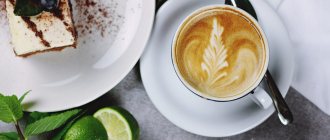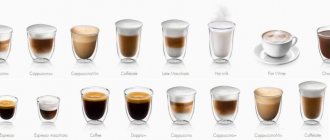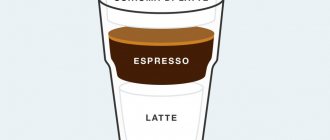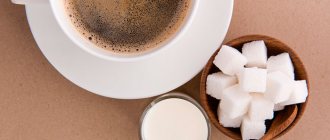Recipe history
Flat white coffee is a drink with history. The barista, through experimentation, selected the proportions of the main ingredients so that they did not drown out each other. To do this, Derek Townsend initially replaced a large layer of milk foam with a thin one. After this, the proportions of milk and coffee were changed. The amount of milk was reduced and the amount of coffee increased when compared to Latte and Cappuccino. To prepare Flat White, you need to maintain a 1:2 coffee to milk ratio.
Additionally, the barista reduced the extraction time (the process allows the flavor and aroma of ground coffee beans to be revealed) by 8 seconds. The above changes made it possible to preserve both the taste of coffee and milk in the drink.
Calories Flat White
The calorie content of the drink depends on the fat content of the milk used. With a milk fat concentration of 2.5-3.2%, the energy value of coffee will be 70-80 kcal. If the milk is skim, then the calorie content of Flat White will be approximately 35 kcal. You should also consider the amount of sugar in the drink. The energy value in one teaspoon of sugar is 34 kcal.
Flat white coffee, the calorie content of the drink depends on the type of milk and the presence of sugar.
For comparison, the calorie content of Latte coffee is 115 kcal, and Cappuccino 105 kcal.
Matcha latte
Recipe: 1 shot of espresso, 1 tsp. matcha tea, 235 ml milk
Calorie content: 350 kcal
Caffeine: 80 mg
This coffee from Japan is rich in antioxidants and boosts immunity.
How many calories are in coffee from your favorite coffee shop?
CHOCOLATE
- Cappuccino (100 ml) – 35 kcal
- Latte (400 ml) – 219 kcal
- Cappuccino light (320 ml) – 127 kcal
- Raf coffee (400 ml) – 344 kcal
- Americano (100 ml) – 52 kcal
- Cocoa (200 ml) - 361 kcal
Difference from other coffee drinks
Flat white coffee is a drink consisting of espresso and milk. Latte and Cappuccino coffees are also prepared with these ingredients. A comparative analysis of these drinks is discussed in the table below.
| Name of coffee | Proportions of ingredients used | Difference in taste |
| Cappuccino | The proportions of milk and coffee (simple espresso) are equal (60 ml each). In this case, the milk must be thoroughly whisked before adding. As a result, the drink contains less milk than milk foam, which is laid out in the form of a cone at the final stage of coffee preparation. The drink is usually served in cups with a volume of 150-180 ml. | The aroma and taste of the main ingredients mix and drown each other out. As a result, the drink does not have a pronounced milk or coffee taste and aroma. |
| Latte | The ratio of coffee (simple espresso) to milk in the drink is 1:3 (the recipe requires 60 ml of espresso and 180 ml of milk). Milk must be poured into a container with coffee in a very thin stream so that a foam approximately 1 cm thick forms on the surface of the drink. Coffee is served in cups of 250-300 ml. | The drink has a pronounced milky taste that overpowers the taste of coffee. |
| Flat White | The proportions of coffee (usually double espresso) and milk are 1:2 (standard volumes are 60 ml of coffee and 120 ml of milk). In this case, during the preparation process, you need to pour 10 ml of the total volume of milk and beat them until foam forms. The foam needs to be spread on top of the drink in an even thin layer last. The drink is served in cups with a volume of 150-180 ml. | The drink completely retains the taste of coffee and milk, which do not mix and do not suppress each other. |
The main external difference between the drinks is the different proportions of milk and coffee, as well as the height of the milk foam.
What it is
This drink filled an unoccupied niche, receiving the sympathy of those who wanted to make the taste of espresso softer and the taste of cappuccino livelier. The name of the drink comes from the English “flat white coffee”, which translates as “flat white”.
In fact, this is not easy, because the name refers to the form of presentation. The milk is frothed to a smooth structure so that the surface of the coffee is absolutely uniform and as smooth as possible. This is precisely what makes it different from cappuccino (after all, the drinks are served in identical cups and volumes, so they can be easily confused), because the foam is presented in the form of a small cone.
By the way, an interesting fact is that many coffee shops often serve a regular latte instead of a flat white, so look carefully at the foam. In a latte it is mostly brown and a little milky, while in a flat white the amount of white foam is in equal proportions with coffee-brown foam.
There is another theory about the origin of the name. It says that the male part of New Zealand refused to order coffee with added milk because they were convinced that it was not a man’s drink, so they came up with their own strong “flat white” for men.
Ingredient Requirements
The main ingredients of Flat White coffee are milk and coffee beans.
To ensure that the ingredients do not interrupt each other’s taste, but rather emphasize each other, the following requirements are imposed on them:
- To make coffee, use only Arabica beans, without including Robusta (the beans have a very tart and strong taste). If desired, you can mix several types of Arabica beans. For example, Indian and Kenyan types, which are distinguished by the presence of a chocolate aftertaste;
- The roasting of the beans should be light or medium. Since coffee made from dark roasted beans does not taste well with milk and gives the drink a pronounced bitterness;
- The grinding of the grains should be fine or medium. So that espresso easily reveals the taste and aroma of coffee;
- Beans should be roasted and ground before preparing the drink to preserve the coffee aroma;
- water for making espresso should not only be non-chlorinated, but also soft. Acceptable mineralization is in the range of 75-250 mg/l;
- espresso before preparing the drink should have a temperature in the range of 35-70 degrees;
- It is recommended to use only whole milk. That is, apart from heat treatment (not boiling), the milk is not processed in any way and nothing is added to it;
- You cannot use boiled milk for cooking, as otherwise you will not get foam with the desired texture. The permissible milk temperature range before preparing the drink is 60-70 degrees;
- The recommended milk fat concentration is 2.5-3.2%. With a higher fat content, milk can interrupt the coffee taste and aroma. Lower fat content means additional processing of milk in the form of skimming.
It is also important to maintain the proportions of the main ingredients. Otherwise, the taste of the drink will not correspond to what is declared.
Characteristics of Flat White coffee
Flat White, when prepared correctly, retains the flavor of milk and coffee beans. That is, the drink turns out strong and at the same time gentle. Due to the use of double espresso, drinking coffee more than 2 times a day is not recommended. Classic Flat White has a slight bitterness, which is muted by milk foam. The tonic effect after drinking the drink is high (higher than cappuccino) due to the double dosage of coffee beans. The approximate coffee strength of the drink is 80 mg per cup.
It is possible to prepare analogues of Flat White coffee using almond or coconut milk. At the same time, the taste and texture of the drink will differ from the original.
Breve
Recipe: 2 parts espresso, 1 part steamed milk, 1 part cream
Calorie content: 240 kcal
Caffeine: 80 mg
A very French version of a latte with thick foam.
How many calories are in coffee from your favorite coffee shop?
COFFEE HOUSE
- Double cappuccino (100 ml) – 64 kcal
- Latte (100 ml) – 44 kcal
- Double Cappuccino Caramel (100 ml) – 85 kcal
- Double Cappuccino Chocolate-Mint (100 ml) – 142 kcal
- Double Cappuccino Banana Split (100 ml) – 86 kcal
- Double Cappuccino Ice (100 ml) – 125 kcal
- Irish coffee (100 ml) - 136 kcal
- Cocoa (100 ml) – 119 kcal
Homemade recipes
Violation of proportions or incorrect choice of ingredients will spoil the taste and texture of coffee.
Classic recipe
To prepare classic Flat White coffee, you need to prepare the following ingredients (proportions are indicated for one serving of the drink):
- Arabica beans (or a combination of Arabica beans) – 14 g;
- water purified from impurities (soft) – 60 ml;
- whole cow's milk – 110 ml;
- granulated sugar (cane) - the amount of the ingredient should be varied to taste.
If you don’t have a coffee machine, you will need to prepare 60 ml of ready-made espresso and 110 ml of milk.
Next, the coffee brewing process consists of the following steps:
- Arabica beans should be roasted. Finished beans should be light or medium roasted.
- Then you need to grind the Arabica beans in a coffee grinder to a medium or fine grind.
- Place crushed Arabica beans, water and granulated sugar into a coffee maker or coffee machine. Set the espresso brewing program.
- While the coffee is preparing, you should heat the milk to a temperature of 60 degrees.
- Divide the milk into 2 equal parts and beat one part with a mixer or cappuccino maker until foam forms.
- Carefully combine both parts of milk.
- Next, pour the espresso into a ceramic cup and gradually pour milk into it. When poured correctly, some of the milk will mix with the coffee, and some will form a thin milk foam on the surface. It is important to pour milk into coffee, and not vice versa.
It is recommended to drink coffee warm; as it cools, the coffee will fully reveal the desired taste and aroma. If you don’t have a coffee machine or coffee maker, espresso can be brewed in a Turk (the proportions of the products are similar). To do this, you need to pour the prepared Arabica coffee into a dry coffee pot and heat the coffee over moderate heat for no more than 10 seconds.
Next, you need to pour granulated sugar into the Turk and pour in water heated to 45 degrees. Put the Turk on the fire. When foam appears, the Turk should immediately be removed from the heat and wait until the foam settles. Then the Turk needs to be put back on the fire until the foam forms again. Next, the Turk needs to be removed from the heat again; when the foam settles, the coffee can be poured into a ceramic cup.
When preparing espresso in a Turk, the taste of Flat White coffee will differ from the original.
Flat White Mocha
The drink has a delicate chocolate and creamy taste.
To prepare it (for 1 cup), you will need products from the following list:
- finely ground roasted Arabica beans – 18 g;
- water purified from impurities – 90 ml;
- whole milk with a fat content of 3.2% - 45 ml;
- ready-made hot chocolate (white) – 45 ml;
- whipped cream (fat content 33%) – 45 ml;
- grated milk chocolate - the amount of the ingredient should be varied according to taste.
If desired, milk chocolate can be replaced with white or dark chocolate.
After preparing the ingredients, the sequential preparation of coffee consists of the following steps:
- Place Arabica and water in the coffee machine. Install the espresso program.
- Pour the hot chocolate into the pitcher (container for whipping milk drinks) and lightly whisk it.
- Pour the hot chocolate into a tall coffee glass.
- Next, you need to heat the milk to 70 degrees and carefully pour it into a glass of hot chocolate. It is recommended to carry out manipulations with a spoon.
- Similarly, using a spoon, pour espresso on top of the milk.
- Then you need to whip the cream and pour it on top of the espresso.
Decorate the finished drink with grated chocolate.
Features of this drink - double espresso
The taste of espresso doppio will delight any coffee lover, as it is very rich and dense, rich in flavor nuances - nutty notes mixed with herbs, with a slight bitterness, giving the drink piquancy and delicacy.
The key feature of doppio is its volume. If a standard serving of espresso usually does not exceed 60 milliliters, then doppio is twice as large - about 120 milliliters. An interesting fact is that in different countries it is customary to brew espresso with different volumes. How much drink will you get? If you order a portion:
- In Italy - 30-45 milliliters.
- In France, Spain and almost all other European countries - 55-60 milliliters.
- In America - 70-80 milliliters.
As you can see, American baristas are traditionally more generous in preparing this drink. In Russia, the prevailing recipes and technologies for making coffee come to us from European countries. Along with them, domestic baristas also adopted the standard volumes of classic espresso - 60 milliliters.
If we talk about doppio, then in general it is very similar to espresso, as it is brewed according to a similar recipe and similar technology. Doppio is known and loved by coffee lovers, as it is distinguished by its rich taste and bright, tart aroma of natural freshly brewed coffee, which will not leave anyone indifferent.
A coffee machine is used to brew Doppio espresso. A drink that is close to the original taste can also be obtained by using a geyser coffee maker. However, it is unlikely that you will be able to achieve high-quality doppio by brewing coffee in a Turkish coffee pot. It is in the coffee machine that you can set the optimal pouring and brewing time so that the ground beans can give out all the best - essential oils, caffeine-rich tannins, and other components.
Interestingly, the quality of espresso doppio can be assessed with high accuracy without even trying it! Coffee connoisseurs know that the secret is in the foam. It is also called “crema”, and by its quality and appearance you can judge how the drink will taste.
Please note:
- If the cream foam is thick and uniform, milky-brown in color, and covers the entire surface of the drink without breaks, the doppio is of high quality and its taste will be dense and rich.
- If the cream foam is liquid and has large bubbles, does not cover the entire surface of the drink and has a white tint, the coffee will turn out to be watery and undercooked. And its taste will not be the best, since the grains have not completely given up all their beneficial substances.
- If the crema is dark brown, the espresso doppio will be too bitter, as the cream acquires this appearance if the beans have been roasted too heavily. This is burnt coffee, some people like its taste, but there are not very many connoisseurs of it.
Signs of improper preparation
Flat white coffee is a drink that has no analogues in taste.
If the choice of ingredients is violated or the rules for their preparation and mixing are not followed, the following deviations are noted:
- pronounced bitterness of the drink. Bitterness can be caused by choosing the wrong type of coffee bean or over-roasting the Arabica;
- lack of milk foam with the desired texture. The defect is typical for boiled milk;
- foam too high. The milk was not frothed correctly;
- There is little taste of coffee. Violation of the proportions of milk and coffee or insufficient espresso strength;
- there is a taste of baked milk. This symptom is present if the milk has been heated above 70 degrees;
- the taste of coffee mixed with milk. The defect is noted if milk was initially poured into the cup, and then coffee.
Also, if coffee is consumed immediately after preparation, the taste will differ from the original. According to the rules, the drink should steep for approximately 10 minutes.
How to serve and drink coffee?
Flat White is usually prepared and served in wide 200 ml ceramic cups without stirring. Otherwise, the milk foam, which softens the coffee taste, will settle. It is recommended to serve the drink with a chocolate bar (some of the chocolate can be grated on top of the milk foam), nut cookies or berry jelly.
It is important that it is recommended to drink coffee in the morning, no more than 2 cups per day and no more than 4 cups per week, due to the high caffeine content.
Flat White will have a rich coffee taste if double espresso is used to prepare it, and there is a thin milk foam on the surface. The advantage of this drink is the convenience of its decoration. Coffee foam preserves any patterns.
What popular coffee shops serve it?
Currently, Flat White is served in almost all coffee shops in the world. Here are some of the most popular ones where you can drink a cup of aromatic drink:
- The Starbucks coffee chain has more than 24 thousand retail outlets all over the world, 100 of which are already operating in Russia.
- An equally large chain is Costa Coffee, which includes about 1,100 open coffee shops in the UK and about 560 around the world.
- Pret a Manger is a famous London coffee chain founded in 1983.
- “Coffeemania” is one of the popular coffee shops in Moscow, where you can also enjoy the “Australian” drink.
You can buy coffee at a price of 250 rubles per cup of 200 ml.
Flat white is an excellent invigorating drink with a bright and rich aroma. It will appeal to those coffee lovers who prefer an intermediate option between espresso and cappuccino. In addition to the drink, you can order a couple of sweet desserts and enjoy its delicate notes with a pleasant bitterness. And avid flat white lovers should, if possible, visit coffee shops in other cities and countries in order to compare where the traditions and craftsmanship have been preserved at the highest level.











